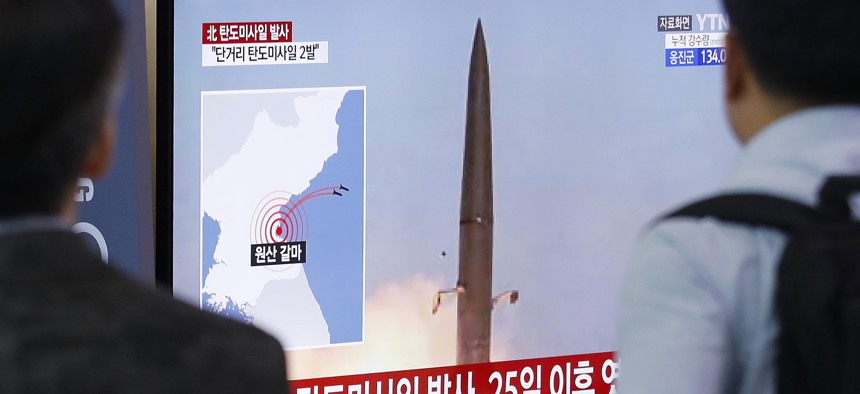
People watch a TV showing a file image of North Korea's missile launch during a news program at the Seoul Railway Station in Seoul, South Korea, Wednesday, July 31, 2019. AP Photo/Ahn Young-joon
How Long Can Trump Keep Ignoring Kim’s Missile Tests?
It’s becoming harder for the president to overlook the fact that the man with whom he claims to have fantastic chemistry is literally going ballistic.
He dismissed the first firings of missiles in May, which shattered an 18-month spell of no North Korean provocations, as “some small weapons, which disturbed some of my people, and others, but not me.” He pooh-poohed the next pair of missile launches last week, which came less than a month after he embraced Kim Jong Un and became the first American president to step into North Korea, as “short-range missiles, and many people have those missiles.”
But with the latest tests of such missiles, conducted this week off North Korea’s east coast, it’s becoming more difficult for Donald Trump to ignore the fact that the man with whom he claims to have fantastic chemistry is literally going ballistic, for all the world to see. Whether in the form of more displays of short-range weapons or a test of a longer-range missile, Kim could soon test Trump’s seemingly abundant store of patience.
Trump likes to point out that Kim has continued to refrain from testing long-range missiles and nuclear weapons that directly endanger the United States and that brought the two countries to the brink of military conflict in 2017. This restraint, however, is only as enduring as Kim’s interest in sustaining nuclear talks with the United States—as North Korea’s foreign ministry plainly stated earlier this month by threatening to resume nuclear and intercontinental-ballistic-missile tests if the U.S. and South Korea go ahead with planned military exercises in August.
In sending Washington and Seoul the occasional explosive reminder of how liable their détente is to suddenly dissipate, Kim is probably not aiming to nix the negotiations. He may, instead, be seeking to build leverage in those talks. (The tests also advance North Korean military capabilities and help Kim shore up support at home.) The North Korea expert Robert Carlin, for example, told me that he interpreted the foreign ministry’s recent proclamation as an attempt to “rattle” the United States and to emphasize the need for the parties to make “balanced commitments” in an upcoming round of nuclear talks, just as Kim has abstained from nuclear and ICBM tests in return for the U.S. holding off on major military exercises with South Korea.
Yet while the North Koreans are assiduous practitioners of calibrated military provocations, for decades engaging in them ahead of negotiations, the approach is as much art as science. It’s eminently possible that Kim could miscalculate by interpreting Trump’s muted response so far as license to strengthen his hand and ramp up pressure on his American and South Korean counterparts with measures short of nuclear and ICBM tests, only to learn the hard way that he misjudged the Trump administration’s actual red line.
For now, by downplaying these weapons tests and playing up his warm relationship with Kim, Trump appears intent on salvaging his signature foreign-policy initiative and signaling to the North Korean leader that the door to diplomacy remains open if and when he decides to give up nuclear weapons. The administration’s calculation seems to be that there’s no use in treating North Korea’s exercises in letting off steam as though they are five-alarm fires, and that an overreaction by Washington might only redound to North Korea’s benefit and disrupt what many U.S. officials probably view as a tolerable if far from ideal status quo: a reduction of military tensions on the Korean peninsula and a slowdown in Pyongyang’s development of nuclear weapons that could reach the mainland United States. Of late, this posture has necessitated a good deal of inventiveness, including Secretary of State Mike Pompeo minimizing the North Korean leader’s much-publicized inspection of a potentially nuclear-capable submarine by pointing out that he, too, has been photographed visiting military facilities.
Still, Trump’s patience could wear thin even if North Korea’s saber-rattling stays at its current level. Yesterday the president told reporters, “My relationship with Kim Jong Un is a very good one, as I’m sure you’ve seen.” Within hours, Kim was letting loose missiles. It’s not a great look for the president, particularly as he campaigns for reelection. (The North Korean foreign ministry’s recent statement notably singled out Trump, who until then had escaped the ire that Pyongyang regularly directs at the president’s advisers, for proceeding with U.S.–South Korea military drills despite his alleged promise to suspend them.)
As Tim Ryan, one of the Democrats running against Trump, argued yesterday evening, the president “goes to the demilitarized zone with the leader of North Korea, gives him a huge photo op, gives him global credibility because the most powerful person in the world is sitting there meeting with him, and weeks later he’s lobbing more missiles. That doesn’t make any sense.”
NEXT STORY: Two Ways to Ward off Killer Spacecraft




